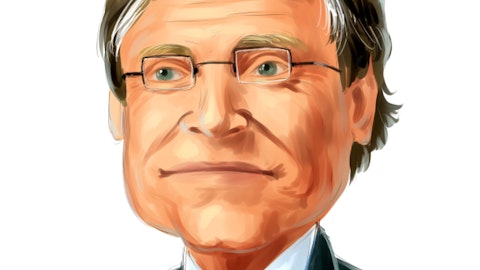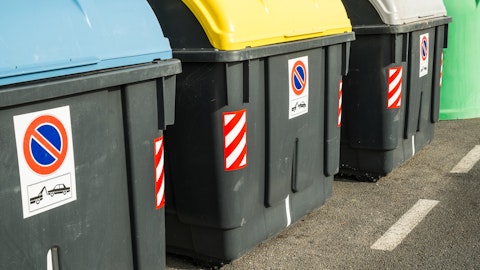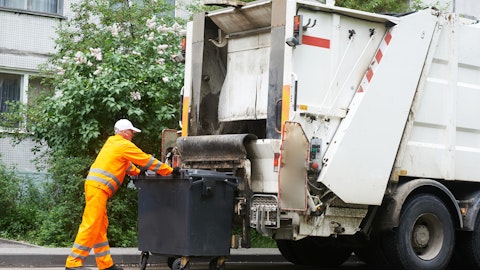Waste Connections, Inc. (NYSE:WCN) Q4 2023 Earnings Call Transcript February 14, 2024
Waste Connections, Inc. isn’t one of the 30 most popular stocks among hedge funds at the end of the third quarter (see the details here).
Operator: Good morning, everyone and welcome to the Waste Connections, Inc. Q4 2023 Earnings Conference Call. [Operator Instructions] Please also note today’s event is being recorded. At this time, I’d like to turn the floor over to Ron Mittelstaedt, President and CEO. Sir, please go ahead.
Ron Mittelstaedt: Okay. Thank you, operator and good morning. I would like to welcome everyone to this conference call to discuss fourth quarter results and our outlook for both the first quarter and full year 2024. I am joined this morning by Mary Anne Whitney, our CFO and several other members of senior management. As noted in our earnings release, adjusted EBITDA margin expansion of 200 basis points in Q4 capped off a remarkable year for Waste Connections, driven by solid execution and continued improvement in operating trends. Solid waste organic growth led by 8.7% core pricing was bolstered by improvements in commodity-driven revenues during the quarter, providing momentum for 2024. Acquisition activity also accelerated into year end as we announced the acquisition of the $225 million revenue E&P waste, disposal-oriented assets of Secure Energy in Western Canada, which has closed as of February 1, bringing expected 2024 revenue contribution from acquisitions to approximately $325 million with incremental dialogue ongoing.
Looking at our differentiated results during the full year 2023, we delivered 70 basis points adjusted EBITDA margin expansion after overcoming 60 basis points in headwinds from recovered commodity values to report an industry leading margin of 31.5%, double-digit growth in both revenue and adjusted EBITDA from price-led organic solid waste growth and outside acquisition contribution, along with disciplined execution and focus on the quality of revenue drove adjusted free cash flow of $1.224 billion or 15.3% of revenue, in line with our outlook. Both employee turnover and safety incident rates exit 2023 at multiyear lows, setting up 2024 for continued improvement in trends, along with the opportunity for outsized margin expansion. Before we get into much more detail, let me turn the call over to Mary Anne for our forward-looking disclaimer and other housekeeping items.
Mary Anne Whitney: Thank you, Ron and good morning. The discussion during today’s call includes forward-looking statements made pursuant to the Safe Harbor provisions of the U.S. Private Securities Litigation Reform Act of 1995, including forward-looking information within the meaning of applicable Canadian securities laws. Actual results could differ materially from those made in such forward-looking statements due to various risks and uncertainties. Factors that could cause actual results to differ are discussed both in the cautionary statement included in our February 13 earnings release and in greater detail in Waste Connections’ filings with the U.S. Securities and Exchange Commission and the securities commissions or similar regulatory authorities in Canada.
You should not place undue reliance on forward-looking statements as there maybe additional risks of which we are not presently aware or that we currently believe are immaterial, which could have an adverse impact on our business. We make no commitment to revise or update any forward-looking statements in order to reflect events or circumstances that may change after today’s date. On the call, we will discuss non-GAAP measures such as adjusted EBITDA, adjusted net income attributable to Waste Connections on both the dollar basis and per diluted share and adjusted free cash flow. Please refer to our earnings releases for a reconciliation of such non-GAAP measures to the most comparable GAAP measures. Management uses certain non-GAAP measures to evaluate and monitor the ongoing financial performance of our operations.
Other companies may calculate these non-GAAP measures differently. I will now turn the call back over to Ron.
Ron Mittelstaedt: Thank you, Mary Anne. 2023 was a remarkable year – excuse me, in many ways and we recognized that there were some unanticipated changes. What didn’t change, however, was the dedication and accountability of our local teams who consistently demonstrated their commitment to the customers and communities we have the privilege to serve. Similarly, we renewed our commitment to a decentralized operating philosophy and servant leadership culture, both of which have served to differentiate Waste Connections and drive industry leading results. As we have indicated, we are extremely pleased with our strong operating and financial performance throughout 2023, most notably driven by momentum in the second half of the year, when adjusted EBITDA margins expanded to an average of 32.4%, with Q4 margin expansion of 200 basis points year-over-year.
During 2023, employee retention improved by over 20%, with a reduction in open positions of over 40%. Most importantly, we also achieved a reduction of over 7% in safety incident rates, with over 60% of our operating locations, showing improvement or zero safety-related incidents during the year. Virtually, all of this improvement occurred in Q3 and Q4, providing momentum into 2024. We delivered core pricing of 9.5% and expanded margins by 70 basis points to report adjusted EBITDA margin of 31.5% for the full year 2023. Excluding 60 basis points margin drag from lower commodity values, underlying margins expanded by 130 basis points during the year, reflecting our focus on revenue quality as well as the impact of abating cost pressures and the improving trends in retention and safety.
All of which contributed to the accelerating margin expansion in the second half of 2023. Looking ahead, 2024 is setup for continued outsized margin expansion from reduced turnover and the unrealized cost benefits of improving risk, along with moderating cost inflation. We delivered adjusted free cash flow of $1.224 billion in ‘23, converting over 48% of adjusted EBITDA to adjusted free cash flow, in line with the increased outlook we provided in August and more than overcoming unanticipated site-specific closure related impacts at our Chiquita Canyon landfill in Southern California. Regarding the elevated temperature landfill event or ETLF at Chiquita Canyon that we have described on our last earnings call in October, we are encouraged by our ongoing progress.
We continue to work with the community and other stakeholders as we manage the ongoing impacts from the underground reaction occurring in a closed portion of our landfill, including the associated leachate generation. As indicated would be the case in the additional disclosure we provided in November, we recorded an increase of approximately $160 million to our landfill closure and post-closure liabilities in Q4 to address and mitigate the ETLF impacts, which are site-specific and non-recurring in nature. During 2023, we incurred approximately $21 million in related costs, slightly below our estimates due to the timing of outlays. Based on current engineering estimates and the projected timeline, with the expectation for leachate generation rates to peak later this year, the outlays for 2024 are expected to be approximately $75 million, which is included in our outlook for adjusted free cash flow as Mary Anne will more fully describe.
Looking next at acquisitions. In 2023, we closed over $215 million in annualized revenue from 13 acquisitions with activity across our footprint of franchises and competitive markets, including integrated markets, new market entries and a number of tuck-ins to existing operations. Additionally, on February 1, we closed the previously announced acquisition of Secure Energy’s E&P waste disposal oriented asset divestitures in Western Canada. Together with the rollover contribution from deals completed during ‘23, this already sets up expected 2024 acquisition contribution of over $325 million, with a robust pipeline of solid waste opportunities coming in ensuing quarters. On top of Secure, 2024 is setup for an outsized M&A year in our core solid waste business.
Stay tuned for the next few quarters. Additionally, we are encouraged by recent movement in the franchise process in New York City, where we have been awarded the right to compete in 12 commercial zones plus citywide compactor service. We look forward to seeing continued progress this year, beginning with a pilot project slated for Q4. As we have noted, recent acquisition activity in the Northeast, including rail access to our Arrowhead landfill in Alabama, has created greater optionality for disposal in many markets and expanded the potentially addressable market for acquisitions for us. That said there is no change to our disciplined approach to acquisitions, our focus on market selection, the risk profiles we accept and the valuations we determined to be appropriate.
Ending 2023 with leverage of approximately 2.6x debt-to-EBITDA and liquidity of over $1.5 billion, our balance sheet strength and free cash flow profile provide flexibility for continuing elevated levels of investments in our organic solid waste growth story, along with renewable energy projects and solid waste acquisitions, while also increasing our return of capital to shareholders. To that end, during 2023, we increased our quarterly per share dividend by 11.8% to return over $270 million to shareholders through dividends. And we invested approximately $1.7 billion in capital expenditures and acquisitions to reinvest in our business and position ourselves for future growth. And now, I’d like to pass the call to Mary Anne to review more in depth the financial highlights of the fourth quarter and provide a detailed outlook for Q1 and full year 2024.

I will then wrap up before heading into Q&A.
Mary Anne Whitney: Thank you, Ron. In the fourth quarter, revenue of $2.036 billion was up $166 million or 8.9% year-over-year bringing full year 2023 revenues to $8.022 billion in line with our expectations and up 11.2% year-over-year. Acquisitions completed since the year ago period contributed about $53 million of revenue in Q4 or about $51 million net of divestitures, bringing full year net acquisition contribution to $407 million. Core pricing in Q4 was 8.7% and range from about 7% in our mostly exclusive market Western region to between about 8.5% and over 10% in our competitive markets. Fuel and material surcharges were negative 80 basis points in the quarter on lower fuel costs. Solid waste volumes in Q4 were down 2.3% and continue to reflect our shedding of poor quality revenues and the non-renewal of municipal contracts as well as a purposeful trade-off between price and volume in some markets.
Additionally, in Q4, they reflect tough comparison to the prior year’s hurricane-related activity in Florida and in Texas, the diversion of waste from our Seabreeze landfill where we impose temporary operating limitations while completing certain repairs. Those diversions concluded at the end of January. Looking at year-over-year results in the fourth quarter on a same-store basis, roll-off pulls per day were about flat and total landfill tons were down about 1%, with MSW flat, special waste up 2% and C&D waste down 9%, due primarily to last year’s hurricane-related volumes, as noted. Adjusting for those impacts in Seabreeze, total tons were up nominally year-over-year. Adjusted EBITDA for Q4, as reconciled in our earnings release, was up 16.4% year-over-year to $656 million or 32.2% of revenue and included an impact of about $5 million from the waste diversion and repairs at Seabreeze noted earlier.
Excluding this 20 basis point impact, our adjusted EBITDA margin was up 220 basis points year-over-year, primarily from underlying solid waste margin expansion. As Ron noted earlier, our Q4 results reflect an adjustment of approximately $160 million to increase our closure and post-closure liabilities for the expected outlays to address the ETLF impacts at Chiquita Canyon projected primarily during 2023 to 2025. Therefore, while there was no impact to adjusted EBITDA, our 2023 adjusted free cash flow reflects outlays for site-specific operating capital outlays to address the ETLF impacts totaling over $21 million. In spite of those incremental outlays, our adjusted free cash flow of $1.224 billion or 15.3% of revenue was in line with our expectations for the year and reflects 48% conversion of adjusted EBITDA.
Capital expenditures of $934 million reflect a similar amount of fleet purchases slipping to ‘24 as we saw in the prior year. Additionally, they include about $40 million associated with renewable natural gas or RNG facilities under development. As discussed on prior calls, our sustainability-related projects include about a dozen RNG facilities, strategic investments with a variety of ownership structures. Aggregate capital outlays through 2025 of approximately $200 million are expected to generate an estimated $200 million of incremental EBITDA by 2026 or about $1 of EBITDA per dollar of CapEx. The outlays for RNG projects step up in 2024 to approximately $150 million, which has been factored into our 2024 outlook, which I will now review along with our outlook for Q1 2024.
Before I do, we would like to remind everyone once again that actual results may vary significantly based on risks and uncertainties outlined in our Safe Harbor statement and filings we’ve made with the SEC and the securities commissions or similar regulatory authorities in Canada. We encourage investors to review these factors carefully. Our outlook assumes no change in the current economic environment. It also excludes any impact from additional acquisitions that may close during the remainder of the year and expensing of transaction-related items during the period. Looking first at the full year 2024. Revenue in 2024 is estimated to increase by over 9% to $8.75 billion. For solid waste, we expect price plus volume of approximately 4.5% to 5.5%, driven by pricing of 6% to 7% on core pricing of about 7%.
About $325 million of estimated revenue in 2024 is from acquisitions closed to-date and commodity-driven revenues reflect values in line with recent levels, plus nominal contribution from RNG facilities expected to come online during 2024. Adjusted EBITDA in 2024, as reconciled in our earnings release, is expected at approximately $2.86 billion or adjusted EBITDA margin of 32.7%, up 120 basis points year-over-year. Continued moderation in inflationary trends, additional acquisitions closed during the year or increases in the values for recovered commodities or in E&P waste activity would provide upside to our 2024 outlook. Depreciation and amortization expense in 2024 is estimated to be about 12.8% of revenue, including amortization of intangibles of about $172 million or $0.49 per diluted share net of taxes.
Interest expense in 2024 is estimated at approximately $280 million and our effective tax rate for 2024 is expected in the range of 23% to 23.5% with some quarter-to-quarter variability. Adjusted free cash flow in 2024, as reconciled in our earnings release, is expected at approximately $1.2 billion on CapEx of approximately $1.15 billion, including base CapEx of $1 billion plus $150 million for RNG project development. As Ron noted earlier, our adjusted free cash flow outlook also reflects $75 million for outlays associated with the Chiquita Canyon ETLF. Normalizing for the outlays for Chiquita and the RNG facilities, 2024 adjusted free cash flow of $1.425 billion reflects conversion of EBITDA of approximately 50%. This level is consistent with longer term trends and in line with our expectations for underlying growth in 2025, when we anticipate outlays for both RNG facilities and Chiquita closure will decline by $170 million.
Incremental tax credits for RNG are not factored into our outlook and would therefore be additive. Similarly, any restoration of bonus depreciation benefits on a retroactive or prospective basis, including to a tax bill currently under consideration would be additive to the outlook we have provided. Turning now to our outlook for Q1 2024. Revenue in Q1 is estimated to be approximately $2.05 billion on expected solid waste price plus volume growth of 3.5%, driven by pricing of about 7%. Volume expectations reflect about 1% in incremental temporary volume losses associated with the widespread weather-driven closures during January across many markets, particularly on the West Coast. Adjusted EBITDA in Q1 is estimated to be up 140 basis points year-over-year to 31.2% of revenue or approximately $640 million.
Depreciation and amortization expense for the first quarter is estimated to be about 12.8% of revenue, including amortization of intangibles of about $40 million or about $0.11 per diluted share net of taxes. Interest expense in Q1 net of interest income is estimated at approximately $76 million and the tax rate for the first quarter is estimated at about 23%. And now, let me turn the call back over to Ron for some final remarks before Q&A.
Ron Mittelstaedt: Thank you, Mary Anne. We are extremely pleased by our 2023 results and our positioning for outsized growth in 2024. With 120 basis points of adjusted EBITDA margin expansion expected as a minimum, along with upside from continued improvement in recovered commodity values or inflationary pressures as well as any additional activity, we are well on our way towards exceeding the near-term 34% EBITDA target we have discussed widely. 2023 was a year of renewal for Waste Connections. With a return to our leadership routes to reinforce our decentralized operating model, supported by a servant leadership-driven culture. We doubled down on human capital. Getting back to the basics that are fundamental to implementing the differentiated strategy has driven our exemplary track record of value creation for 26 years.
We entered 2024 with continued momentum and well-positioned for outsized growth, along with a renewed commitment to sustaining the model that has set us apart. At Waste Connections, we recognize the importance of both relationships and results. Moreover, we believe that not only are they both achievable, but they are necessarily interrelated. We are proud of our results and applaud the local teams who embody the enduring operating values of the company. I want to conclude by thanking our 23,000 employees who work tirelessly to make us better everyday. In addition, I’d like to officially welcome the approximately 300 employees who are now part of our R360 Canada team who previously were with Secure Energy. We also appreciate your time today.
And I will now turn this call over to the operator to open up the lines for your questions. Operator?
Operator: [Operator Instructions] Our first question today comes from Tyler Brown from Raymond James. Please go ahead with your question.
See also 20 Most Meat Eating States Per Capita and 30 Countries with Highest Standard of Living Ranked by GDP (PPP) Per Capita.
Q&A Session
Follow Waste Connections Us Inc. (NYSE:WCN)
Follow Waste Connections Us Inc. (NYSE:WCN)
Tyler Brown: Hey, good morning.
Ron Mittelstaedt: Good morning, Tyler.
Mary Anne Whitney: Hey, Tyler.
Tyler Brown: Hey, Ron. Mary Anne, actually thank you for all the detail. But margins here, both in Q4 and the outlook are quite strong. I was just hoping if you could maybe walk us through the 200 basis point improvement for Q4. Maybe walk through the expected improvement for 2024 as well, just kind of what some of those key pieces are?
Mary Anne Whitney: Sure. Happy to do. So as I said in the prepared remarks, Q4 was primarily the underlying solid waste business. The way to think about it is about 75% of the improvement was there and the balance in hierarchy would be recycled commodities and then RINs and then a nominal contribution from E&P with a small offset from M&A. So, that’s Q4. And then looking at the full year, as we said, there are three factors that would drive the opportunity for outsized margin expansion, the first one being the underlying business and the opportunity for outsized price cost spread and improving retention. And so, about half of the 120 basis point margin expansion would be driven by the underlying business. And then the two other pieces would be the accretive benefit of acquisitions with the addition of Secure.
So if you think 30 to 40 basis points, including Secure and the other acquisitions, which have that mildly diluted impact and then the balance being the tailwind, recycled commodities and RINs, which would be the smallest piece, but on the order of say, 20 to 30 basis points.
Tyler Brown: Okay. And then Ron, I appreciate the update on turnover and safety. So in that core improvement in ‘24, are you assuming that, that turnover and safety remunerates to margins? It sounds like, yes, because I think you said last quarter, it takes a few months for that to kind of show up in the margins. I just want to be clear if that is in the expectation or not?
Ron Mittelstaedt: Yes. So we have got to separate them a little bit, Tyler. So I would say that certainly turnover at this point is impacting our cost structure and we are starting to see favorably impacting our cost structure. And we are starting to see some of the costs come out of the 100 basis points we have talked about in areas of labor, variable, other operating, etcetera. There is a lag effect on seeing the cost benefit from the risk reductions. So that actually is not factored into ‘24. So as we continue to have risk reductions, we will get that benefit as we come through ‘24 into ‘25 but that is not in the ‘24 guidance. So this margin improvement is without seeing the benefit of that risk in the actuarial tables at this point.
Tyler Brown: Excellent. Okay, that is very helpful. And then I know that there is a lot moving around in free cash flow. That is very clear. Mary Anne, did you say that in ‘23, you spent $40 million on RNG. So if I add that to the $150 million that would imply that maybe your RNG spend next year will drop to something like $10 million and then maybe to zero in ‘26?
Mary Anne Whitney: That’s right, yes. And that’s why the point I made the $170 million reduction between the two pieces where Chiquita steps down and the RNG steps down.
Tyler Brown: Okay. And then my last one here. So it sounds like there is a nominal EBITDA contribution from RNG in ‘24. But how will that schedule look in ‘25 and ‘26. And then, Ron, sorry, just to be clear, when you talk about 34% – is that 34% margins, does that include any benefit from RNG?
Ron Mittelstaedt: Okay. So, let’s tackle the first part of your question first. Let’s start with ‘26. We said that for full year ‘26, we would achieve $200 million of EBITDA on $200 million of CapEx investment for RNG. A very nominal amount of that contribution, as you’ve noted we only outlayed $40 million in ‘23 in RNG. So, a nominal amount of that will contribute in ‘24. Use a number of $15 million, $20 million of EBITDA for ‘24. That will obviously, with the CapEx spend in ‘24, that will ramp some in ‘25 and you’ll start to see some more contribution. But the bulk of that doesn’t come online until the end of the third quarter or so in ‘25. That’s why the largest amount is – why the full amount is in ‘26.
We also are going to be somewhat cautious in guiding RNG as you are seeing across the board, you have to build headroom in these projects. These local utilities are extremely backed up. There are still supply chain issues for things like transformers, generators, etcetera, that they need. And they give us a commitment of X, and 4 to 6 months later, we’re still talking about a hookup. So you have to build a little headroom in there. So that’s why I feel comfortable telling you full contribution by ‘26 in and with some more amount coming in ‘25, then, of course, the $20 million or so in ‘24. So that’s a long way around the bend to say very little to no RNG contribution in that 34%. That’s why we’ve said there are multiple ways to get there, and none of them had RNG in it.
Tyler Brown: Perfect. Yes, thank you for the answer on the double questions. Thank you, guys.
Operator: Our next question comes from Toni Kaplan from Morgan Stanley. Please go ahead with your question.
Toni Kaplan: Thanks so much. Pricing this quarter continue to be strong and you’ll lock in most of it by April, and you’ll have cost inflation moderating. So as we look at margins through the year, should we look at it more as sort of better – well, I guess, one each is probably also helped by the safety and turnover benefits that you’ve been seeing. But like basically, you’ll also see that inflation coming down through the end of the year. So I guess in terms of just trajectory of margins, what are your thoughts on that?
Mary Anne Whitney: Sure. So the way to think about it, Toni, is pretty similar margin expansion over the course of the year. We’ve already given you Q1 at 140 basis points. We give you 120 for the full year. But if you modeled in somewhere around 120 for each quarter, a little less, obviously, in one quarter, since you’ve give me a little more in one. It’s the right way to think about it because just to the point you raised, you have a couple of different factors driving it, some of which will lag and some of which we will get in the first half of the year, for instance, the tail from commodities is greater early than it will be later. But the ability to realize some of those savings and benefits from turnover, for instance, might be further backloaded. And so that’s why I think about it as consistent margin expansion over the course of the year.
Toni Kaplan: Perfect. And then I guess when you think about the labor turnover initiatives that you’ve been doing and you mentioned the turnover at multiyear lows. When you think about the rate continuing? Are you benefiting from market conditions? Or is it the initiatives that you were putting in place last year or a combination of the two? I’m just trying to get at sustainability of the labor turnover level. Thanks.
Ron Mittelstaedt: Yes. Sure, Toni. Well, so let’s start with a little bit of cadence. So coming out of ‘22, we experienced total turnover of – in the low 30s, which was a high for us forever. As we came through into Q2 of ‘23, that number dropped to about 30%, and as we came through the end of the year, that number dropped to about 27%. These are total turnover numbers and the voluntary turnover number reduced to about 17%. I would tell you that the up through probably midyear, most of the help was the labor market improvement and sort of the second half of the year, particularly the end of the third quarter and the fourth quarter, the programs and changes we’ve made were the incremental part. So I would call it sort of 50-50.
Now as we go through ‘24 and we plan to drive this number from 27% down to, say, 22% or below as we sit here from a year from now, that will be 100% driven by what we are doing. And so we have made significant changes in how we recruit. We’ve made significant changes in how we onboard. We’ve made significant changes in sort of the first-year experience of an employee, supervisor development. There is a whole litany of changes that we have made to improve voluntary turnover. We are always going to want to have about 10% to 12% in voluntary turnover. That means we are being proactive on people who might not be the best fit, particularly with regard to safety. So to get to that 2022 percent number, over the next year or so, it’s telling you that voluntary turnover will get down to 10% to 12%.
And we feel very confident in achieving that number. We’ve been there before. But definitely, we still have some work to do.
Toni Kaplan: Super. Thanks so much. Congrats on the quarter.
Ron Mittelstaedt: Thank you.
Operator: Our next question comes from Jerry Revich from Goldman Sachs. Please go ahead with your question.
Adam Bubes: Hi, this is Adam on for Jerry today. Thanks for taking my question. I believe Q1 margin guidance of 31.2% translates to margins down 100 basis points sequentially. If we just look at normal seasonality based off recent historical averages, usually around 9 basis points sequentially, Q1 versus 4Q. Can you just help us understand the puts and takes versus normal seasonality in Q1? I know weather was one item mentioned.
Mary Anne Whitney: I’d say that’s where I would start. There are always idiosyncratic factors that drive the comparability across quarters. And also, just keep in mind this is guidance as opposed to what we’ve reported. And so it’s always a little more difficult to get granular to tell you what the specific drivers are. But weather is a factor, as we said, it’s contributing to outsized negative volumes in the quarter. And so I would start there. And just that’s one consideration that would drive that difference.
Adam Bubes: Okay. Great. And I was just wondering if we could dive in a little further into the M&A pipeline from here, how active is the opportunity set in the Northeast specifically? And what’s a good way to think about potential allocation to M&A this year?
Ron Mittelstaedt: Well, Adam, we never comment on anything that’s not done or completed or provide any specifics on what’s in our pipeline. And we don’t have an allocation to M&A. We sort of have an unlimited finance capacity for M&A that meets our strategic and our financial guidelines. A historical strong year is $150 million to $200 million of acquired revenue. We’ve already done secure, and that’s $225 million. And in my comments, I said on top of that, you can assume an outsized year on top of that. So it sort of implies that we would do comfortably $150 million to $200 million in acquired revenue minimally on top of Secure. So that I think you can figure out from there what in your mind what an allocation would be based on historical valuations, etcetera.
Adam Bubes: Great. Thanks so much.
Operator: Our next question comes from Noah Kaye from Oppenheimer. Please go ahead with your question.
Noah Kaye: Thanks. On the New York commercial zoning strikes home for me literally since I’m in the first pilot zone. So as you move through that, I think you commented during your prepared remarks that plus the rail acquisition seems to be expanding your addressable market opportunity in and around the Northeast. I wonder if you could just expand on that a little bit. Take us through in more detail how both of those moving pieces increase your addressable opportunity?
Ron Mittelstaedt: Well, with the New York City franchise opportunity provides is a number of things. I mean, number one, it provides certainty and sustainability and projectability of the business model in and around New York City, Which has had sort of an uncertain competitive footprint for decades. So it really changes the operating and financial metrics of that market for us, where we have been more quiet waiting for to see if this platform came through and waiting to see whether we were successful in it and achieving it. So now that there is clarity, I think it produces growth opportunities both organically and acquisition-wise in and around the market area, number one. Two, the disposal capacity in the Northeast is constrained, as everyone knows.
We have some great assets, disposal assets in New York and up and along the Eastern Seaboard. But we are effectively at capacity in many of those assets. So we were shipping waste to third-party locations, and we were not able to take incremental volumes into our sites. What the Arrowhead acquisition did for us is it allowed us to internalize volumes that were going to third parties. It also allowed us to pull volumes out of our Northeastern facilities, and attract and contract with new volumes that are pricing in the Northeast for us. So it did that. It also opened up M&A opportunities along the Eastern Seaboard that we otherwise would not have looked at. We are not prone to go in, particularly to a more urbanized market and acquire something that is non integratable.





